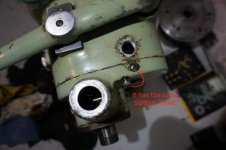spirous
Plastic
- Joined
- Aug 24, 2016
- Location
- thessaloniki, Gr
The gearbox is of "Simonet" make, driving a Schaublin/Simonet 102 hybrid, and i have noticed a quite slow pace leakage out of it. It leaks from both the two opposite sides as indicated in the pictures below. The leakage is quite slow, but in a couple of months, most of the oil has gone missing out of the gearbox.


Some of the screws holding the right mating plate (last image)have been found not been really tighten in place.
Around a quarter of turn was missing.
I' ve been thinking to make gaskets for the mating surfaces, in order to stop having leakage. the type of the screws been factory installed though, have simple slotted heads, not letting much torque to be applied, so i am wondering if the gaskets would be sufficiently pressed in place in order to seal...

I wonder if i should just try to tighten up the screws, refill with oil and wait and see what happens. Or if i should go with the gasket option. The thing is that i already took out the motor and that i would have to refit and wait another couple of months maybe to figure out if this did the fix or not.
On the other hand to fit gaskets would require even more disassembling, again with the possibility to fail, maybe even having misalignment introduced out of the (small) extra thickness..
Any thoughts/advise?


Some of the screws holding the right mating plate (last image)have been found not been really tighten in place.
Around a quarter of turn was missing.
I' ve been thinking to make gaskets for the mating surfaces, in order to stop having leakage. the type of the screws been factory installed though, have simple slotted heads, not letting much torque to be applied, so i am wondering if the gaskets would be sufficiently pressed in place in order to seal...

I wonder if i should just try to tighten up the screws, refill with oil and wait and see what happens. Or if i should go with the gasket option. The thing is that i already took out the motor and that i would have to refit and wait another couple of months maybe to figure out if this did the fix or not.
On the other hand to fit gaskets would require even more disassembling, again with the possibility to fail, maybe even having misalignment introduced out of the (small) extra thickness..
Any thoughts/advise?
Last edited:


